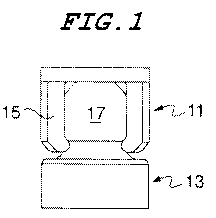Une partie des informations de ce site Web a été fournie par des sources externes. Le gouvernement du Canada n'assume aucune responsabilité concernant la précision, l'actualité ou la fiabilité des informations fournies par les sources externes. Les utilisateurs qui désirent employer cette information devraient consulter directement la source des informations. Le contenu fourni par les sources externes n'est pas assujetti aux exigences sur les langues officielles, la protection des renseignements personnels et l'accessibilité.
L'apparition de différences dans le texte et l'image des Revendications et de l'Abrégé dépend du moment auquel le document est publié. Les textes des Revendications et de l'Abrégé sont affichés :
| (12) Demande de brevet: | (11) CA 3205078 |
|---|---|
| (54) Titre français: | ENSEMBLE DE FIXATION DE CARTE DE CIRCUIT IMPRIME |
| (54) Titre anglais: | CIRCUIT BOARD FASTENER ASSEMBLY |
| Statut: | Demande conforme |
| (51) Classification internationale des brevets (CIB): |
|
|---|---|
| (72) Inventeurs : |
|
| (73) Titulaires : |
|
| (71) Demandeurs : |
|
| (74) Agent: | SMART & BIGGAR LP |
| (74) Co-agent: | |
| (45) Délivré: | |
| (86) Date de dépôt PCT: | 2021-12-10 |
| (87) Mise à la disponibilité du public: | 2022-06-16 |
| Licence disponible: | S.O. |
| Cédé au domaine public: | S.O. |
| (25) Langue des documents déposés: | Anglais |
| Traité de coopération en matière de brevets (PCT): | Oui |
|---|---|
| (86) Numéro de la demande PCT: | PCT/US2021/062840 |
| (87) Numéro de publication internationale PCT: | WO 2022125921 |
| (85) Entrée nationale: | 2023-06-09 |
| (30) Données de priorité de la demande: | ||||||
|---|---|---|---|---|---|---|
|
La présente invention concerne un système de fixation qui comprend deux composants d'interconnexion pour fixer des composants électroniques qui peuvent être joints par encliquetage lorsqu'un élément de fixation est pressé contre un élément de retenue. Le système de fixation est constitué d'un goujon de fixation ayant une base plane au fond et une tige s'étendant vers le haut avec une partie de col de diamètre réduit adjacente à la base. Le goujon comprend une partie sphérique ayant une surface supérieure plane plate au niveau d'une extrémité supérieure distale. Le goujon de fixation s'accouple avec un élément de retenue ayant une base plane et des bras élastiques opposés fixés s'étendant orthogonalement à partir de la base centrée autour d'un axe de rotation. Les bras présentent de préférence des surfaces internes en forme de composé symétriques autour de l'axe. Ces surfaces comprennent une partie cylindrique adjacente à la base et une partie sphérique adjacente aux extrémités distales des bras.
A fastening system comprises two interconnecting components for fastening electronic components which can be joined by snap-fit when a fastener component is pressed against a retainer. The fastening system consists of a fastener stud with a planar base at the bottom and an upwardly extending shank with a neck portion of reduced diameter adjacent the base. The stud has a spherical ball portion with a flat planar top surface at a distal top end. The fastener stud mates with a retainer having a planar base and affixed opposing resilient arms extending orthogonally from the base centered about a rotational axis. The arms preferably have compound shaped inner surfaces symmetrical about the axis. These surfaces comprise a cylindrical portion adjacent the base and a spherical portion adjacent the distal ends of the arms.
Note : Les revendications sont présentées dans la langue officielle dans laquelle elles ont été soumises.
Note : Les descriptions sont présentées dans la langue officielle dans laquelle elles ont été soumises.

2024-08-01 : Dans le cadre de la transition vers les Brevets de nouvelle génération (BNG), la base de données sur les brevets canadiens (BDBC) contient désormais un Historique d'événement plus détaillé, qui reproduit le Journal des événements de notre nouvelle solution interne.
Veuillez noter que les événements débutant par « Inactive : » se réfèrent à des événements qui ne sont plus utilisés dans notre nouvelle solution interne.
Pour une meilleure compréhension de l'état de la demande ou brevet qui figure sur cette page, la rubrique Mise en garde , et les descriptions de Brevet , Historique d'événement , Taxes périodiques et Historique des paiements devraient être consultées.
| Description | Date |
|---|---|
| Lettre envoyée | 2023-07-17 |
| Demande reçue - PCT | 2023-07-13 |
| Inactive : CIB en 1re position | 2023-07-13 |
| Inactive : CIB attribuée | 2023-07-13 |
| Exigences applicables à la revendication de priorité - jugée conforme | 2023-07-13 |
| Exigences quant à la conformité - jugées remplies | 2023-07-13 |
| Demande de priorité reçue | 2023-07-13 |
| Exigences pour l'entrée dans la phase nationale - jugée conforme | 2023-06-09 |
| Demande publiée (accessible au public) | 2022-06-16 |
Il n'y a pas d'historique d'abandonnement
Le dernier paiement a été reçu le 2023-11-06
Avis : Si le paiement en totalité n'a pas été reçu au plus tard à la date indiquée, une taxe supplémentaire peut être imposée, soit une des taxes suivantes :
Veuillez vous référer à la page web des taxes sur les brevets de l'OPIC pour voir tous les montants actuels des taxes.
| Type de taxes | Anniversaire | Échéance | Date payée |
|---|---|---|---|
| Taxe nationale de base - générale | 2023-06-09 | 2023-06-09 | |
| TM (demande, 2e anniv.) - générale | 02 | 2023-12-11 | 2023-11-06 |
Les titulaires actuels et antérieures au dossier sont affichés en ordre alphabétique.
| Titulaires actuels au dossier |
|---|
| PENN ENGINEERING & MANUFACTURING CORP. |
| Titulaires antérieures au dossier |
|---|
| ANTHONY COLOSI |